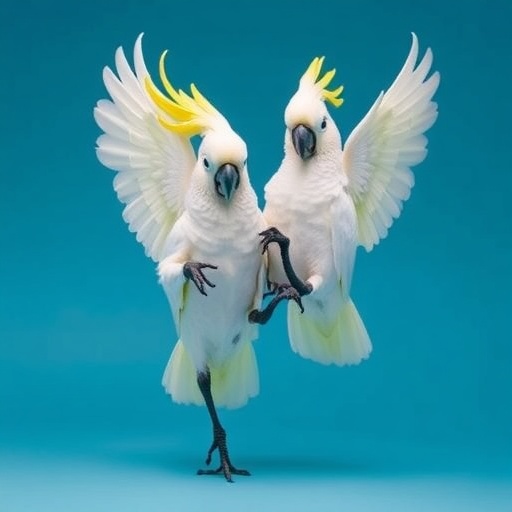In a groundbreaking new study published in PLOS One, scientists have unveiled the astonishing complexity and diversity of dance behaviors in captive cockatoos, shedding light on the cognitive and emotional capacities of these vibrant birds. Led by Natasha Lubke of Charles Sturt University, Australia, the research meticulously documents at least 30 distinct dance movements performed by cockatoos, nearly half of which have never been described before. These findings not only expand our understanding of avian behavior but also suggest promising avenues for enhancing the welfare of these charismatic parrots in captivity.
Cockatoos, belonging to the family Cacatuidae, have long fascinated observers with anecdotal accounts of their rhythmic responses to music, but until now, systematic scientific analysis was sparse. By analyzing 45 videos sourced from social media platforms alongside experimental observations of captive birds at the Wagga Wagga Zoo, the study deciphers the complexity embedded within cockatoo dancing. Researchers cataloged a rich ethogram of movements ranging from vigorous headbanging to fluid body rolls, illustrating a repertoire that rivals many forms of animal display behaviors previously thought to be unique or rare.
This research is significant because rhythmic synchronization to auditory stimuli, particularly music, is a rare phenomenon in the animal kingdom. Apart from humans, only a few bird species, notably parrots, have demonstrated an ability to dance spontaneously in time with music, implicating advanced neural processes. Dancing in cockatoos is not merely a mechanical movement but a sophisticated behavior that involves imitation, learning, and motor coordination. The neurological underpinnings suggest parallels to human cognitive functions associated with rhythm perception, social bonding, and emotional expression.
Lubke and her colleagues identified a total of 30 unique dance movements among the captured videos and live subjects, with 17 new movements added to the scientific lexicon. These include energetic sidesteps, expressive headbanging, and intricate body rolls. Interestingly, individual birds also exhibited idiosyncratic combinations of these moves, creating unique “dance signatures.” This individual variation underscores the flexibility and creativity in cockatoo motor behavior, akin to personalized dance styles in humans.
One of the most fascinating aspects of this study lies in the variation of dance repertoires between species. Despite their close genetic relatedness, different cockatoo species exhibited distinctive top-ten lists of common dance moves, highlighting a species-specific dimension to this behavior. This variability challenges simplistic views that animal behaviors are purely instinctive or reflexive, suggesting instead a cultural or learned component that merits further exploration.
The researchers extended their study beyond video analysis to experimental trials with six individual cockatoos at Wagga Wagga Zoo, representing three different species. These birds were subjected to multiple auditory conditions — music, an audio podcast, and silence — to examine the influence of sound on their dancing. Remarkably, all the subjects danced under all conditions, demonstrating that the propensity to move rhythmically may be partially independent of musical stimuli but possibly linked to spontaneous motor activity or social signaling.
The implications of these findings reach deeply into the welfare considerations for captive parrots. Dance behavior, often interpreted as a sign of positive affective states, could be leveraged as an indicator of wellbeing. Dr. Lubke emphasizes that encouraging dancing through environmental enrichment, such as music exposure, might offer significant benefits in captive care settings. This is particularly poignant considering the cognitive complexity of cockatoos and their susceptibility to stress in captivity.
Furthermore, this research enhances the growing body of evidence that birds experience a rich emotional life. The expressive nature of cockatoo dance parallels human emotional displays, suggesting that these animals possess well-developed affective states. The convergences between human and parrot dancing open exciting possibilities for studying comparative cognitive science and unraveling the evolutionary roots of rhythm and emotion.
The study also posits an intriguing evolutionary background for cockatoo dance behavior. Many of the observed dance moves bear resemblance to courtship displays in wild parrots, implying that the repertoire seen in captivity may have originated as mating rituals. The redirection of such complex motor sequences towards human caretakers hints at the adaptive and social nature of these birds, which have evolved to interact closely with others in their environment.
Music’s role in stimulating dance in captive birds deserves further investigation. While cockatoos danced even in silence, auditory stimuli, especially music, could amplify or modulate their movements in ways that might improve mental stimulation and emotional health. Professor Freire, a co-author, highlights that these behavioral parallels with human dancing underscore the need to explore music’s potential as a non-invasive and enjoyable form of enrichment in aviculture.
Looking ahead, the study calls for more in-depth research into the motivational drivers behind cockatoo dancing, the neurological mechanisms at play, and the possible benefits for captive bird welfare. Developing a more nuanced understanding of how parrots perceive and respond to rhythmic stimuli could revolutionize husbandry practices, ensuring that these intelligent birds not only survive but thrive in managed environments.
In summary, this pioneering work reshapes our understanding of avian dance as a multifaceted behavior rich in variation, individual expression, and cognitive implications. It insists that cockatoos are far more than mere pets with quirky habits; they are sentient creatures capable of complex, joyful movement that bridges sensory perception, emotion, and social interaction in ways previously unappreciated.
Subject of Research: Animals
Article Title: Dance behaviour in cockatoos: Implications for cognitive processes and welfare
News Publication Date: 6 August 2025
Web References: http://dx.doi.org/10.1371/journal.pone.0328487
References: Lubke N, Held SD, Massaro M, Freire R (2025) Dance behaviour in cockatoos: Implications for cognitive processes and welfare. PLoS One 20(8): e0328487.
Image Credits: Lubke et al., 2025, PLOS One, CC-BY 4.0
Keywords: cockatoos, dance behavior, parrot cognition, rhythmic synchronization, animal welfare, behavioral ethogram, music and animals, captive bird enrichment, avian emotion, motor learning, species variation, courtship display




